
Opium is dried latex obtained from the seed capsules of the opium poppy Papaver somniferum. Approximately 12 percent of opium is made up of the analgesic alkaloid morphine, which is processed chemically to produce heroin and other synthetic opioids for medicinal use and for the illegal drug trade. The latex also contains the closely related opiates codeine and thebaine, and non-analgesic alkaloids such as papaverine and noscapine. The traditional, labor-intensive method of obtaining the latex is to scratch ("score") the immature seed pods (fruits) by hand; the latex leaks out and dries to a sticky yellowish residue that is later scraped off and dehydrated. The word meconium historically referred to related, weaker preparations made from other parts of the opium poppy or different species of poppies.

Laudanum is a tincture of opium containing approximately 10% powdered opium by weight. Laudanum is prepared by dissolving extracts from the opium poppy in alcohol (ethanol).
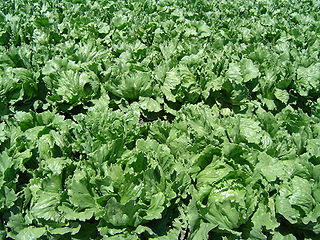
Lettuce is an annual plant of the family Asteraceae. It is most often grown as a leaf vegetable, but sometimes for its stem and seeds. Lettuce is most often used for salads, although it is also seen in other kinds of food, such as soups, sandwiches and wraps; it can also be grilled. One variety, celtuce, is grown for its stems, which are eaten either raw or cooked. In addition to its main use as a leafy green, it has also gathered religious and medicinal significance over centuries of human consumption. Europe and North America originally dominated the market for lettuce, but by the late 20th century the consumption of lettuce had spread throughout the world. As of 2021, world production of lettuce and chicory was 27 million tonnes, 53 percent of which came from China.

A tincture is typically an extract of plant or animal material dissolved in ethanol. Solvent concentrations of 25–60% are common, but may run as high as 90%. In chemistry, a tincture is a solution that has ethanol as its solvent. In herbal medicine, alcoholic tinctures are made with various ethanol concentrations, which should be at least 20% alcohol for preservation purposes.
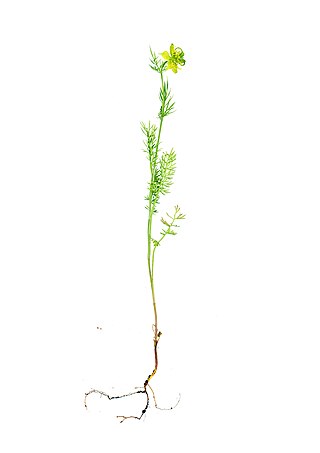
Nigella is a genus of 18 species of annual plants in the family Ranunculaceae, native to Southern Europe, North Africa, South Asia, Southwest Asia and Middle East. Common names applied to members of this genus are nigella, devil-in-a-bush or love-in-a-mist.

Harmala alkaloids are several alkaloids that increase effects of reward system neurotransmitter dopamine by acting as monoamine oxidase inhibitors (MAOIs). These alkaloids are found in the seeds of Peganum harmala, as well as leaves of tobacco and coffee beans. The alkaloids include harmine, harmaline, harmalol, and their derivatives, which have similar chemical structures, hence the name "harmala alkaloids". These alkaloids are of interest for their use in Amazonian shamanism, where they are derived from other plants. Harmine, once known as telepathine and banisterine, is a naturally occurring beta-carboline alkaloid that is structurally related to harmaline, and also found in the vine Banisteriopsis caapi. Tetrahydroharmine is also found in B. caapi and P. harmala. Dr. Alexander Shulgin has suggested that harmine may be a breakdown product of harmaline. Harmine and harmaline are reversible inhibitors of monoamine oxidase A (RIMAs). They can stimulate the central nervous system by inhibiting the metabolism of monoamine compounds such as serotonin and norepinephrine.

Cannabis sativa is an annual herbaceous flowering plant. The species was first classified by Carl Linnaeus in 1753. The specific epithet sativa means 'cultivated'. Indigenous to Eastern Asia, the plant is now of cosmopolitan distribution due to widespread cultivation. It has been cultivated throughout recorded history and used as a source of industrial fiber, seed oil, food, and medicine. It is also used as a recreation drug and for religious and spiritual purposes.

Harmaline is a fluorescent indole alkaloid from the group of harmala alkaloids and beta-carbolines. It is the partly hydrogenated form of harmine.

Nigella sativa is an annual flowering plant in the family Ranunculaceae, native to eastern Europe and western Asia, but naturalized over a much wider area, including parts of Europe, northern Africa and east to Myanmar. It is used as a spice in many cuisines.

Lactuca virosa is a plant in the Lactuca (lettuce) genus, often ingested for its mild analgesic and sedative effects. It is related to common lettuce, and is often called wild lettuce, bitter lettuce, laitue vireuse, opium lettuce, poisonous lettuce, tall lettuce, great lettuce or rakutu-karyumu-so.

Lactucopicrin (Intybin) is a bitter substance that has a sedative and analgesic effect, acting on the central nervous system. It is a sesquiterpene lactone, and is a component of lactucarium, derived from the plant Lactuca virosa, as well as being found in some related plants such as Cichorium intybus. It is also found in dandelion coffee.
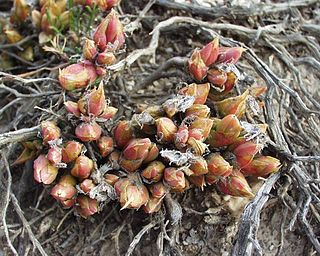
Mesembryanthemum tortuosum is a succulent plant in the family Aizoaceae native to the Cape Provinces of South Africa. It is known as kanna, channa, kougoed —which literally means, 'chew(able) things' or 'something to chew'.

Lactuca serriola, also called prickly lettuce, milk thistle, compass plant, and scarole, is an annual or biennial plant in the tribe Cichorieae within the family Asteraceae. It has a slightly fetid odor and is commonly considered a weed of orchards, roadsides and field crops. It is the closest wild relative of cultivated lettuce.

Lactuca canadensis is a species of wild lettuce known by the common names Canada lettuce, Canada wild lettuce, and tall lettuce. Its true native range is not clear, but it is considered to be a native of the eastern and central parts of North America. It naturalized in the western part of the continent as well as in Eurasia.

Tetrahydropalmatine (THP) is an isoquinoline alkaloid found in several different plant species, mainly in the genus Corydalis, but also in other plants such as Stephania rotunda. These plants have traditional uses in Chinese herbal medicine. The pharmaceutical industry has synthetically produced the more potent enantiomer Levo-tetrahydropalmatine (Levo-THP), which has been marketed worldwide under different brand names as an alternative to anxiolytic and sedative drugs of the benzodiazepine group and analgesics such as opiates. It is also sold as a dietary supplement.

Coronaridine, also known as 18-carbomethoxyibogamine, is an alkaloid found in Tabernanthe iboga and related species, including Tabernaemontana divaricata for which it was named.

Psychoactive plants are plants, or preparations thereof, that upon ingestion induce psychotropic effects. As stated in a reference work:
Psychoactive plants are plants that people ingest in the form of simple or complex preparations in order to affect the mind or alter the state of consciousness.
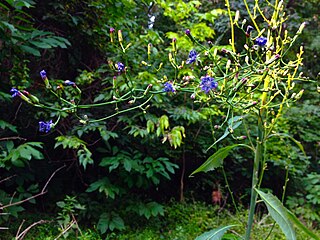
Lactuca floridana, commonly known as woodland lettuce, Florida lettuce, or false lettuce is a North American species of wild lettuce. It is native across much of central Canada and the eastern and central United States.

α-Hederin (alpha-hederin) is a water-soluble pentacyclic triterpenoid saponin found in the seeds of Nigella sativa and leaves of Hedera helix.
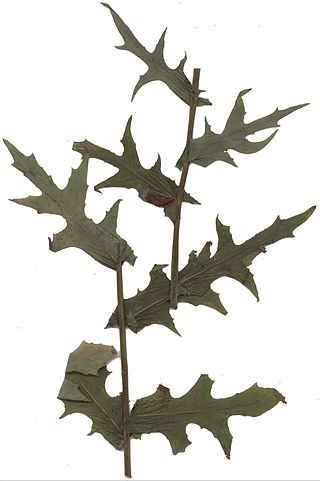
Lactuca quercina is a species of wild lettuce native to Europe and Asia. It is an annual or biennial herb in the tribe Cichorieae within the family Asteraceae growing from a taproot to maximum heights of 50–200 cm (19.5–78.5 in) or more.






















